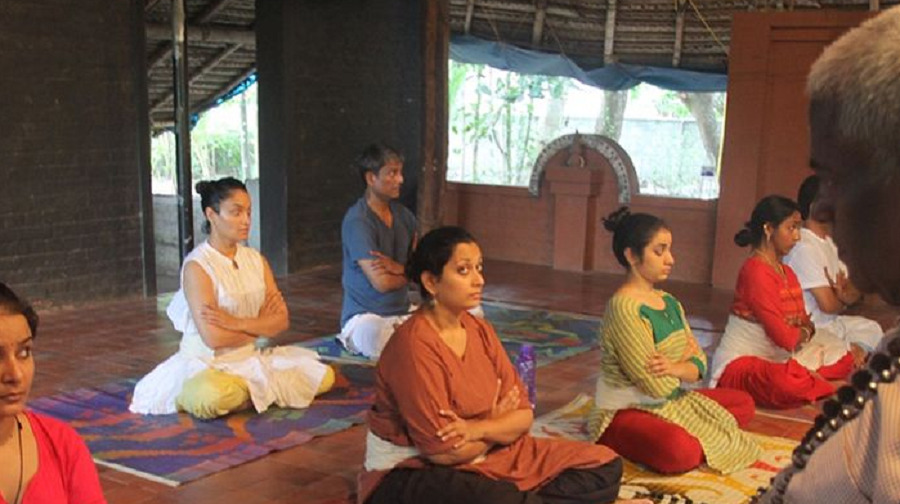Kutiyattam scholar G. Venu’s Navarasa Sadhana , a unique actor training methodology, that moulded numerous actors , completes fifty workshops .
Many years ago, Tirunalan Sasitharan, the celebrated theatre educator and co-founder of Singapore’s Intercultural Theatre Institute (ITI) happened to watch G. Venu, the Kutiyattam scholar and performer, train a group of students at Natana Kairali, Irinjalakuda. He was awe-struck. It was Sasitharan’s first exposure to the ancient theatre form of Kutiyattam. He was fascinated by the force of the emotions which were being conveyed by the actors. He asked Venu if there was some way in which the contemporary actor could be enabled to convey the emotions in the same way.
Thus began a long journey that culminated in Venu developing ‘Navarasa Sadhana,’ a unique actors’ training methodology that acts as a bridge between India’s ancient legacy of abhinaya and the contemporary performers. G. Venu, or Venuji, as he is popularly addressed, explored the vast ocean of Natyashastra, and the actors’ training methodology of Kutiyattam for developing it. He was also inspired by the experimentations conducted at the beginning of the 20th century at Kodungallur Kalari, a centre of learning which was based at Kodungallur Kovilakam, the palace of the erstwhile royal family of Kodungallur.
“But, Navarasa Sadhana is not Kutiyattam,” corrects Venuji. “It’s also not a system of training that had existed at the Kodungallur Kalari.” Rather, it is a methodology that helps the actors reach better levels of emotional expression making use of the acting techniques used in Kutiyattam, following the principles of Natyashastra.
Fifty workshops
Following the suggestion of Sasitharan, Venuji started working with the students of ITI in Singapore from 2005, and trying to draft an actor-training programme based on the Indian acting traditions. Two years later, he started teaching the students of the National School of Drama (NSD), New Delhi, the same programme, imparting the traditional Indian acting methodology to the contemporary theatre students. However, it was the Marathi actor Kalyanee Mulay who compelled him to start teaching Navarasa Sadhana as a course.
The Navarasa Sadhana workshops have now crossed the half a century mark. The onset of the pandemic in 2020 and the ensuing lockdown did not deter Venuji, who took the workshops online. The conclusion of the 50th Navarasa Sadhana Workshop was celebrated on March 1, 2021, with an international webinar titled Navarasa Suvarna Mudra with inaugural lecture by Tom Kingdon, Professor Emeritus, Emerson College, Boston. Prof. Kingdon had pointed out how Venuji had succeeded in linking ‘performed emotions’ (emotions reached on stage) to the emotions we experience in everyday life, in a way that is thoroughly consistent with his own training and with satvika acting and which is, at the same time, accessible to those coming from a non-Sanskrit tradition.
Training emotions
“ I was completely mesmerized by the power of this form,’ Sasitharan who was speaking at Navarasa Suvarna Mudra recalled his first encounter with Kutiyattam. It was then that he realised how in this form, “the actor’s sole responsibility, the sole purpose of his craft, is the conveyance of emotion.” Congratulating Venuji on the completion of 50 courses of Navarasa Sadhana, Sasitharan pointed out how it enables the actor to achieve the highest form of his craft which is vulnerability. “He can be, or she can be, completely or utterly vulnerable in order for the emotion to channel through to the audience.”
Shireen Saif, Dubai-based actor and dancer who has attended two phases of Navarasa Sadhana delivered the key-note address at the Navarsa Suvarna Mudra webinar, speaking of ‘Breath,’ the most important aspect of human life and how breath can be used for transitioning from one emotion to another. Noted art critic George S Paul who offered felicitations, spoke of the courage and confidence that the workshop had instilled in the participants, from his personal interactions with the workshop participants in the pre-Covid times.
Bharatanatyam dancer Meera Sreenarayanan from Chennai, the US-based Bharatanatyam dancer and actor Divya Unni, dancer Prachi Saathi, Meera Balachandran Gokul, Gayatri Krishnaveni Lakshmanan and Vidya Pradeep presented recorded talks at the webinar. Noted Bharatanatyam dancer Dakshina Vaidyanathan, Italian performer Giorgia Ciampi, Divya Ravi, Kuchipudi dancer Pranamya Suri and Samjukta Wagh presented recorded performances. The whole event was beautifully compèred by Kapila Venu, the celebrated Kutiyattam performer and Executive Director, Natana Kairali.

